Angle-Dispersion-Free Near-Infrared Transparent Bands in One-Dimensional Photonic Hypercrystals
Abstract
1. Introduction
2. Angle-Dispersion-Free Near-Infrared Transparent Bands in 1-D PHCs
3. Impacts of Layer Thickness Disturbance on the Angle-Dispersion-Free Property of Near-Infrared Transparent Bands
4. Discussion
4.1. Angle-Dispersion-Free Near-Infrared Stop Bands and Transparent Bands in 1-D PHCs Constructed by Alternating Si Layers and HDMM Layers Realized by Si/In:CdO Subwavelength Multilayers (CD)6
4.2. Impact of Duty Cycle of Si Inside the Si/ITO Subwavelength Multilayer (CD)6 on the Angle-Dispersion-Free Property of the Near-Infrared Transparent Band
4.3. Impact of the Number of Periods in 1-D PHC on the Angle-Dispersion-Free Property of the Near-Infrared Transparent Band
4.4. Simulated Magnetic Field Distributions at Wavelengths of Four Transmittance Peaks Within the Transparent Band
4.5. Impact of Temperature on the Angle-Dispersion-Free Property of the Near-Infrared Transparent Band
5. Conclusions
Author Contributions
Funding
Institutional Review Board Statement
Informed Consent Statement
Data Availability Statement
Conflicts of Interest
References
- Yablonovitch, E. Inhibited spontaneous emission in solid-state physics and electronics. Phys. Rev. Lett. 1987, 58, 2059–2062. [Google Scholar] [CrossRef] [PubMed]
- John, S. Strong localization of photons in certain disordered dielectric superlattices. Phys. Rev. Lett. 1987, 58, 2486–2489. [Google Scholar] [CrossRef] [PubMed]
- Markos, C.; Travers, J.C.; Abdolvand, A.; Eggleton, B.J.; Bang, O. Hybrid photonic-crystal fiber. Rev. Mod. Phys. 2017, 89, 045003. [Google Scholar] [CrossRef]
- Fan, S.; Villeneuve, P.R.; Joannopoulos, J.D. Large omnidirectional band gaps in metallodielectric photonic crystals. Phys. Rev. B 1996, 54, 11245–11251. [Google Scholar] [CrossRef] [PubMed]
- Akahane, Y.; Asano, T.; Song, B.S.; Noda, S. High-Q photonic nanocavity in a two-dimensional photonic crystal. Nature 2003, 425, 944–947. [Google Scholar] [CrossRef] [PubMed]
- Spektor, G.; Zang, J.; Dan, A.; Briles, T.C.; Brodnik, G.M.; Liu, H.X.; Black, J.A.; Carlson, D.R.; Papp, S.B. Photonic bandgap microcombs at 1064 nm. APL Photonics 2024, 9, 021303. [Google Scholar] [CrossRef] [PubMed]
- Wang, H.; Fang, Y. Achieving Transparent Photonic Band in Regular One-Dimensional Photonic Crystal. J. Infrared Millim. Waves 2011, 32, 47–54. [Google Scholar] [CrossRef]
- Luo, J.; Yang, Y.; Yao, Z.; Lu, W.X.; Hou, B.; Hang, Z.H.; Chan, C.T.; Lai, Y. Ultratransparent media and transformation optics with shifted spatial dispersions. Phys. Rev. Lett. 2016, 117, 223901. [Google Scholar] [CrossRef] [PubMed]
- Zhu, Y.N.; Zhou, Y.W.; Qin, B.; Qin, R.; Qiu, M.; Li, Q. Night-time radiative warming using the atmosphere. Light Sci. Appl. 2023, 12, 268. [Google Scholar] [CrossRef] [PubMed]
- Fink, Y.; Winn, J.N.; Fan, S.; Chen, C.; Michel, J.; Joannopoulos, J.D.; Thomas, E.L. A dielectric omnidirectional reflector. Science 1998, 282, 1679–1682. [Google Scholar] [CrossRef] [PubMed]
- Jiang, H.T.; Chen, H.; Li, H.Q.; Zhang, Y.W. Omnidirectional gap and defect mode of one-dimensional photonic crystals containing negative-index material. Appl. Phys. Lett. 2003, 83, 5386–5388. [Google Scholar] [CrossRef]
- Wan, B.-F.; Zhou, Z.-W.; Xu, Y.; Zhang, H.-F. A theoretical proposal for a refractive index and angle sensor based on one-dimensional photonic crystal. IEEE Sens. J. 2020, 21, 331–338. [Google Scholar] [CrossRef]
- Qin, Y.M.; Ma, H.F.; Wu, L.W.; Cui, T.J. Manipulating the light-matter interaction in a topological photonic crystal heterostructure. Opt. Express 2020, 28, 34904–34915. [Google Scholar] [CrossRef] [PubMed]
- Fort, T.; Kanok, R.; Hlubina, P.; Pokorny, P.; Sobota, J. One-dimensional photonic crystals with different termination layer thicknesses and very narrow Bloch surface wave and guided wave based resonances for sensing application. Photonics 2022, 9, 561. [Google Scholar] [CrossRef]
- Wu, F.; Chen, M.; Xiao, S.Y. Wide-angle polarization selectivity based on anomalous defect mode in photonic crystal containing hyperbolic metamaterials. Opt. Lett. 2022, 47, 2153–2156. [Google Scholar] [CrossRef] [PubMed]
- Mogni, E.; Pellegrini, G.; Gil-Rostra, J.; Yuber, F.; Simone, G.; Fossati, S.; Dostálek, J.; Vázquez, R.M.; Osellame, R.; Celebrano, M. One-Dimensional Photonic Crystal for Surface Mode Polarization Control. Adv. Opt. Mater. 2022, 10, 2200759. [Google Scholar] [CrossRef]
- Wu, F.; Liu, T.; Xiao, S.Y. Polarization-sensitive photonic bandgaps in hybrid one-dimensional photonic crystals composed of all-dielectric elliptical metamaterials and isotropic dielectrics. Appl. Opt. 2023, 62, 706–713. [Google Scholar] [CrossRef] [PubMed]
- Liang, W.Y.; Dong, Y.J.; Wen, L.; Long, Y.B. Silicon-based planar devices for narrow-band near-infrared photodetection using Tamm plasmon. Nanophotonics 2024, 13, 2961–2970. [Google Scholar] [CrossRef] [PubMed]
- Konov, Y.V.; Pykhtin, D.A.; Bikbaev, R.G.; Timofee, I.V. Tamm plasmon polariton-based planar hot-electron photodetector for the near-infrared regio. Nanoscale 2024, 16, 9570–9575. [Google Scholar] [CrossRef] [PubMed]
- Zhang, X.M.; Yu, G.X.; Yuan, G.Y.; Lv, Y.H. Unidirectional transmission in one dimensional photonic crystal composed of PT symmetric and magneto-optical material. Opt. Mater. 2021, 114, 110771. [Google Scholar] [CrossRef]
- Javid, M.; Entezar, S.R.; Madani, A. One-dimensional photonic crystal-based optical diodes for pulse source. Phys. Lett. A 2025, 537, 130330. [Google Scholar] [CrossRef]
- Bruyant, A.; Lerondel, G.; Reece, P.J.; Gal, M. All-silicon omnidirectional mirrors based on one-dimensional photonic crystals. Appl. Phys. Lett. 2003, 82, 3227–3229. [Google Scholar] [CrossRef]
- Gao, B.X.; George, J.P.; Beeckman, J.; Neyts, K. Design, fabrication and characterization of a distributed Bragg reflector for reducing the étendue of a wavelength converting system. Opt. Express 2020, 28, 12837–12846. [Google Scholar] [CrossRef] [PubMed]
- Tian, N.; Feng, L.; Ren, Y.Z.; Yu, R.X.; Zhang, X.J.; Xu, T. Polarization-insensitive optical angular filtration enabled by defective photonic crystal. Appl. Phys. Lett. 2022, 120, 241104. [Google Scholar] [CrossRef]
- Liu, Y.L.; Li, H.S.; Tong, H.X.; Wu, A.M.; Huang, H.; Cao, T.; Ding, A. Rational design and construction of [Si/SiO2]N one-dimensional photonic crystal for low infrared emissivity and visible light camouflage. Opt. Laser Eng. 2023, 167, 107641. [Google Scholar] [CrossRef]
- Huang, B.; Gu, P.; Yang, L. Construction of one-dimensional photonic crystals based on the incident angle domain. Phys. Rev. E 2003, 68, 046601. [Google Scholar] [CrossRef] [PubMed]
- Krumbholz, N.; Gerlach, K.; Rutz, F.; Koch, M.; Piesiewicz, R.; Kürner, T.; Mittleman, D. Omnidirectional terahertz mirrors: A key element for future terahertz communication system. Appl. Phys. Lett. 2006, 88, 202905. [Google Scholar] [CrossRef]
- Kong, X.; Liu, S.; Zhang, H.; Li, C.; Bian, B. Omnidirectional photonic band gap of one-dimensional ternary plasma photonic crystal. J. Opt. 2011, 13, 035101. [Google Scholar] [CrossRef]
- Afinogenov, B.I.; Bessonov, V.O.; Nikulin, A.A.; Fedyani, A.A. Observation of hybrid state of Tamm and surface plasmon-polaritons in one-dimensional photonic crystal. Appl. Phys. Lett. 2013, 103, 061112. [Google Scholar] [CrossRef]
- Rashidi, A.; Hatef, A.; Namdar, A. On the enhancement of light absorption in vanadium dioxide/1D photonic crystal composite nanostructure. J. Phys. D Appl. Phys. 2018, 51, 375102. [Google Scholar] [CrossRef]
- Du, G.Q.; Zhou, X.C.; Pang, C.; Zhang, K.Y.; Zhao, Y.P.; Lu, G.; Liu, F.; Wu, A.L.; Akhmadaliev, S.; Zhou, S.Q.; et al. Efficient modulation of photonic bandgap and defect modes in all-dielectric photonic crystals by energetic ion Beam. Adv. Opt. Mater. 2020, 8, 2000426. [Google Scholar] [CrossRef]
- Saleki, Z.; Majarshin, A.J.; Luo, Y.A.; Zhang, D.L. Spectral statistics of light in one-dimensional graphene-based photonic crystal. Phys. Rev. E 2021, 104, 014116. [Google Scholar] [CrossRef] [PubMed]
- Liu, X.J.; Shi, J.X.; Wang, Y.X.; Sun, S.Y.; Chen, B.; Wang, X.F. Wide-angle insensitive dual-mode polarization absorber in the mid-infrared based on Fabry-Perot cavity configuration. Sens. Actuat. A Phys. 2024, 377, 115767. [Google Scholar] [CrossRef]
- Mischok, A.; Siegmund, B.; Roux, F.L.; Hillebrandt, S.; Vandewal, K.; Gather, M.C. Breaking the angular dispersion limit in thin film optics by ultra-strong light-matter coupling. Nat. Commun. 2024, 15, 10529. [Google Scholar] [CrossRef] [PubMed]
- Poddubny, A.; Iorsh, I.; Belov, P.; Kivshar, Y. Hyperbolic metamaterials. Nat. Photonics 2013, 7, 948–957. [Google Scholar] [CrossRef]
- Baqir, M.A.; Choudhury, P.K. Hyperbolic metamaterial-based UV absorber. IEEE Photonics Technol. Lett. 2017, 29, 1548–1551. [Google Scholar] [CrossRef]
- Newman, W.D.; Cortes, C.L.; Afshar, A.; Cadien, k.; Meldrum, A.; Fedosejevs, R.; Jacob, Z. Observation of long-range dipole-dipole interactions in hyperbolic metamaterial. Sci. Adv. 2018, 4, eaar5278. [Google Scholar] [CrossRef] [PubMed]
- Janaszek, B.; Tyszka-Zawadzka, A.; Szczepański, P. Full control of density of states in integrated hyperbolic metamaterial waveguide. Opt. Express 2024, 32, 25104–25117. [Google Scholar] [CrossRef] [PubMed]
- Li, S.; Feng, G.; Liu, Y.C.; Wu, M.; Zhao, X.D.; Sun, F.; Gan, Z.X.; Chen, Z.H.; Yang, Y.B. Omnidirectional near-infrared narrowband filters based on defective mirror-symmetry one-dimensional photonic crystals containing hyperbolic metamaterial. Opt. Laser Eng. 2024, 176, 108107. [Google Scholar] [CrossRef]
- Wang, Z.; Nasir, S.; Bharadwaj, S.; Bharadwaj, S.; Liu, Y.C.; Mambakkam, S.V.; Yu, M.Y.; Law, S. Terahertz Dirac Hyperbolic Metamaterial. ACS Photonics 2024, 11, 4134–4143. [Google Scholar] [CrossRef]
- Wu, F.; She, Y.; Jiang, H.; Liu, G.; Chen, G.; Xiao, S. Angle-immune strong coupling between two defect modes in a defective photonic hypercrystal. Opt. Laser Eng. 2025, 186, 108842. [Google Scholar] [CrossRef]
- Narimanov, E.E. Photonic hypercrystals. Phys. Rev. X 2014, 4, 041014. [Google Scholar] [CrossRef]
- Xue, C.-H.; Ding, Y.; Jiang, H.-T.; Li, Y.; Wang, Z.-S.; Zhang, Y.-W.; Chen, H. Dispersionless gaps and cavity modes in photonic crystals containing hyperbolic metamaterials. Phys. Rev. B 2016, 93, 125310. [Google Scholar] [CrossRef]
- Wei, Q.; Bi, D.; Qi, X.; Ren, M.; Wu, F. Angle-independent topological interface states in one-dimensional photonic crystal heterostructures containing hyperbolic metamaterial. Opt. Lett. 2025, 50, 451–454. [Google Scholar] [CrossRef] [PubMed]
- Shen, K.-S.; Li, X.-K.; Zheng, Y.; Liu, H.-C.; Dong, S.-Q.; Zhang, J.; Xia, S.-Q.; Dong, C.; Sun, X.-L.; Zhang, X.-Z.; et al. Near-infrared ITO-based photonic hypercrystals with large angle-insensitive bandgaps. Opt. Lett. 2022, 47, 917–920. [Google Scholar] [CrossRef] [PubMed]
- Almawgani, A.H.M.; Medhat, M.; Mehaney, A.; Ali, G.A.; Irfan, M.; Elsayed, H.A. One-dimensional metamaterial photonic crystals comprising gyroidal and hyperbolic layers as an angle-insensitive reflector for energy applications in IR regions. Eur. Phys. J. Plus 2023, 138, 483. [Google Scholar] [CrossRef]
- Lu, G.; Wu, F.; Zheng, M.J.; Chen, C.X.; Zhou, X.C.; Diao, C.; Liu, F.; Du, G.Q.; Xue, C.H.; Jiang, H.T.; et al. Perfect optical absorbers in a wide range of incidence by photonic heterostructures containing layered hyperbolic metamaterials. Opt. Express 2019, 27, 5326–5336. [Google Scholar] [CrossRef] [PubMed]
- Cui, L.Y.; Du, G.Q.; Ng, J. Angle-independent and-dependent optical binding of a one-dimensional photonic hypercrystal. Phys. Rev. A 2020, 102, 023502. [Google Scholar] [CrossRef]
- Türker-Kaya, S.; Huck, C.W. A review of mid-infrared and near-infrared imaging: Principles, concepts and applications in plant tissue analysis. Molecules 2017, 22, 168. [Google Scholar] [CrossRef] [PubMed]
- Cui, C.; Ding, Q.M.; Yu, S.Y.; Yu, C.L.; Jiang, D.Y.; Hu, C.Q.; Gu, Z.Q.; Zhu, J.Q. Strategies to break the trade-off between infrared transparency and conductivity. Prog. Mater. Sci. 2023, 136, 101112. [Google Scholar] [CrossRef]
- Palik, E. Handbook of Optical Constants of Solids; Academic Press: Cambridge, MA, USA, 1998. [Google Scholar]
- Guo, P.; Diroll, B.T.; Huang, W.; Zeng, L.; Wang, B.; Bedzyk, M.J.; Facchetti, A.; Marks, T.J.; Chang, R.P.H.; Schaller, R.D. Low-loss near-infrared hyperbolic metamaterials with epitaxial ITO-In2O3 multilayers. ACS Photonics 2018, 5, 2000–2007. [Google Scholar] [CrossRef]
- Gerfin, T.; Grätzel, M. Optical properties of tin-doped indium oxide determined by spectroscopic ellipsometry. J. Appl. Phys. 1996, 79, 1722–1729. [Google Scholar] [CrossRef]
- Wood, B.; Pendry, J.B.; Tsai, D.P. Directed subwavelength imaging using a layered metal-dielectric system. Phys. Rev. B 2006, 74, 115116. [Google Scholar] [CrossRef]
- Li, J.; Zhou, L.; Chan, C.T.; Sheng, P. Photonic band gap from a stack of positive and negative index materials. Phys. Rev. Lett. 2003, 90, 083901. [Google Scholar] [CrossRef] [PubMed]
- Yeh, P. Optical Waves in Layered Media; Wiley: Hoboken, NJ, USA, 1988. [Google Scholar]
- Subramania, G.; Fischer, A.J.; Luk, T.S. Optical properties of metal-dielectric based epsilon near zero metamaterials. Appl. Phys. Lett. 2012, 101, 241107. [Google Scholar] [CrossRef]
- Ning, R.; Li, D.; Yang, T.; Chen, Z.; Qian, H. Wideband and large angle electromagnetically induced transparency by the equivalent transmission line in a metasurface. Sci. Rep. 2019, 9, 15801. [Google Scholar] [CrossRef] [PubMed]
- Lv, Q.; Jin, C.; Zhang, B.; Yin, L.; Liu, S.; Tian, B.; Cui, T.J. Ultrawide-angle ultralow-reflection phenomenon for transverse electric mode in anisotropic meteasurface. Adv. Opt. Mater. 2022, 10, 2102400. [Google Scholar] [CrossRef]
- Gao, Y.; Luo, Y.; Zhang, J.; Huang, Z.; Zheng, B.; Chen, H.; Ye, D. Full-parameter omnidirectional transformation optical devices. Nat. Sci. Rev. 2024, 11, nwad171. [Google Scholar] [CrossRef] [PubMed]
- Yang, Y.; Kelley, K.; Sachet, E.; Campoine, S.; Luk, T.; Maria, J.; Sinclair, M.; Brener, L. Femtosecond optical polarization switching using a cadmium oxide-based perfect absorber. Nat. Photonics 2017, 11, 390–395. [Google Scholar] [CrossRef]
- Dwivedi, S.; D’heer, H.; Bogaerts, W. Maximizing fabrication and thermal tolerances of all-silicon FIR wavelength filters. IEEE Photonics Technol. Lett. 2015, 27, 871–874. [Google Scholar] [CrossRef]
- Kim, G.D.; Lee, H.S.; Park, C.H.; Lee, S.S.; Lim, B.T.; Bae, H.K.; Lee, W.G. Silicon photonic temperature sensor employing a ring resonator manufactured using a standard CMOS process. Opt. Express 2010, 18, 22215–22221. [Google Scholar] [CrossRef] [PubMed]

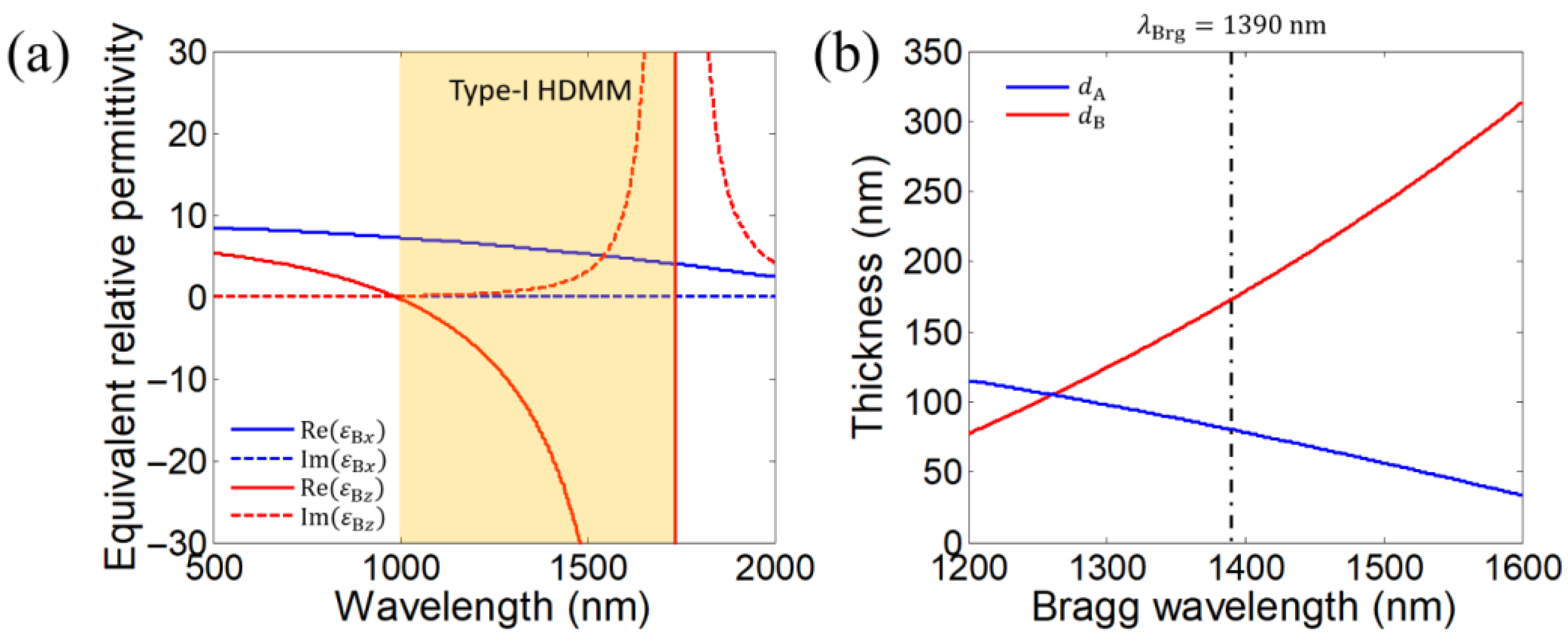
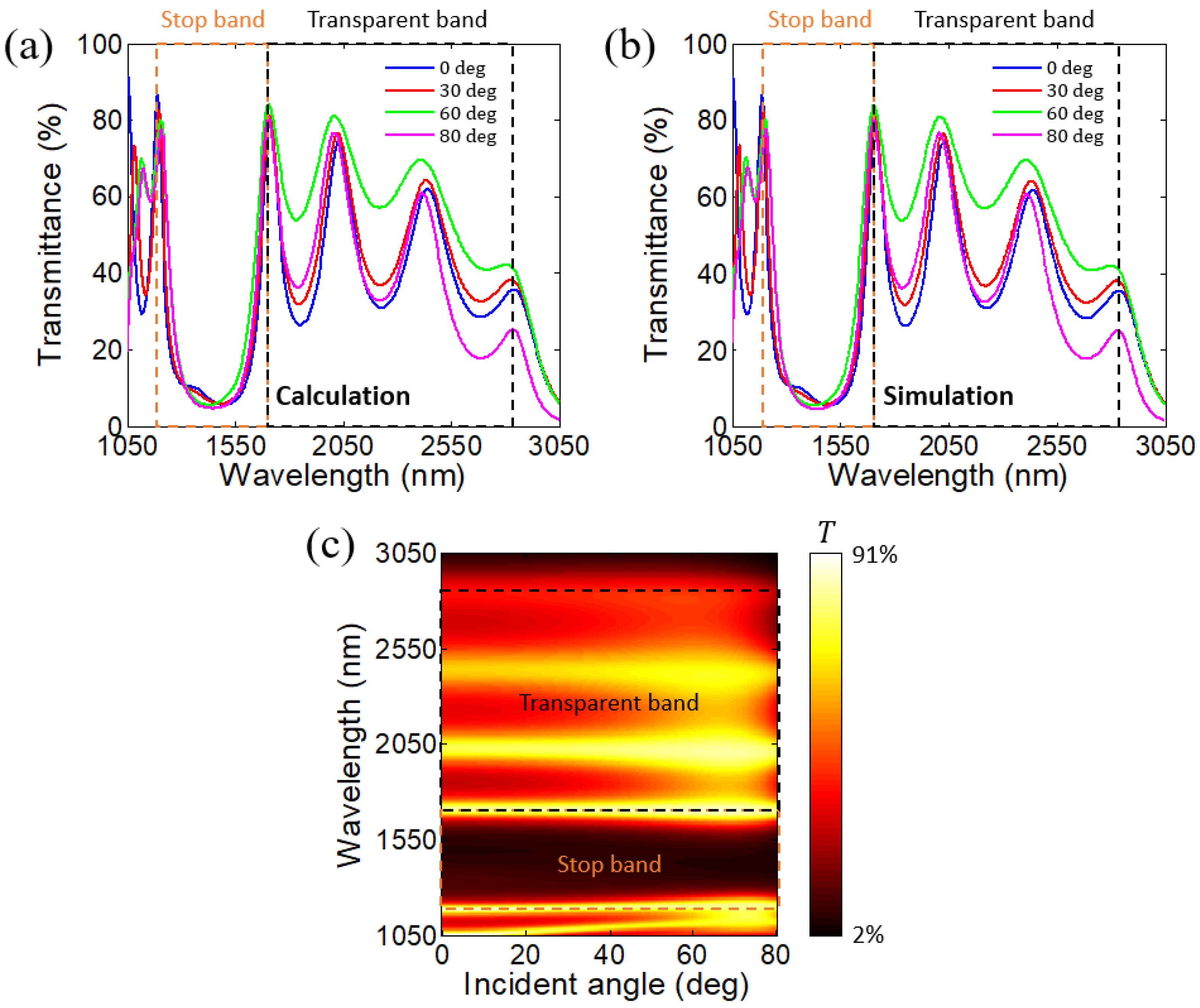
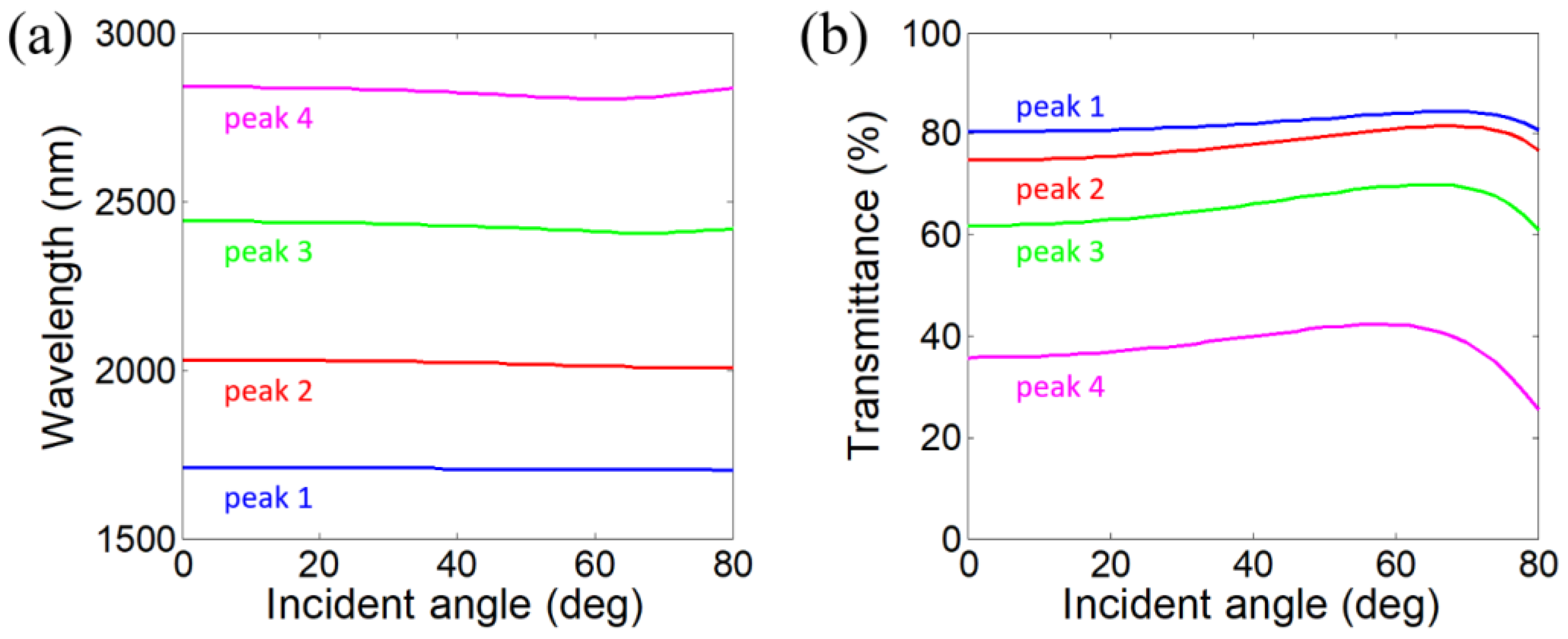
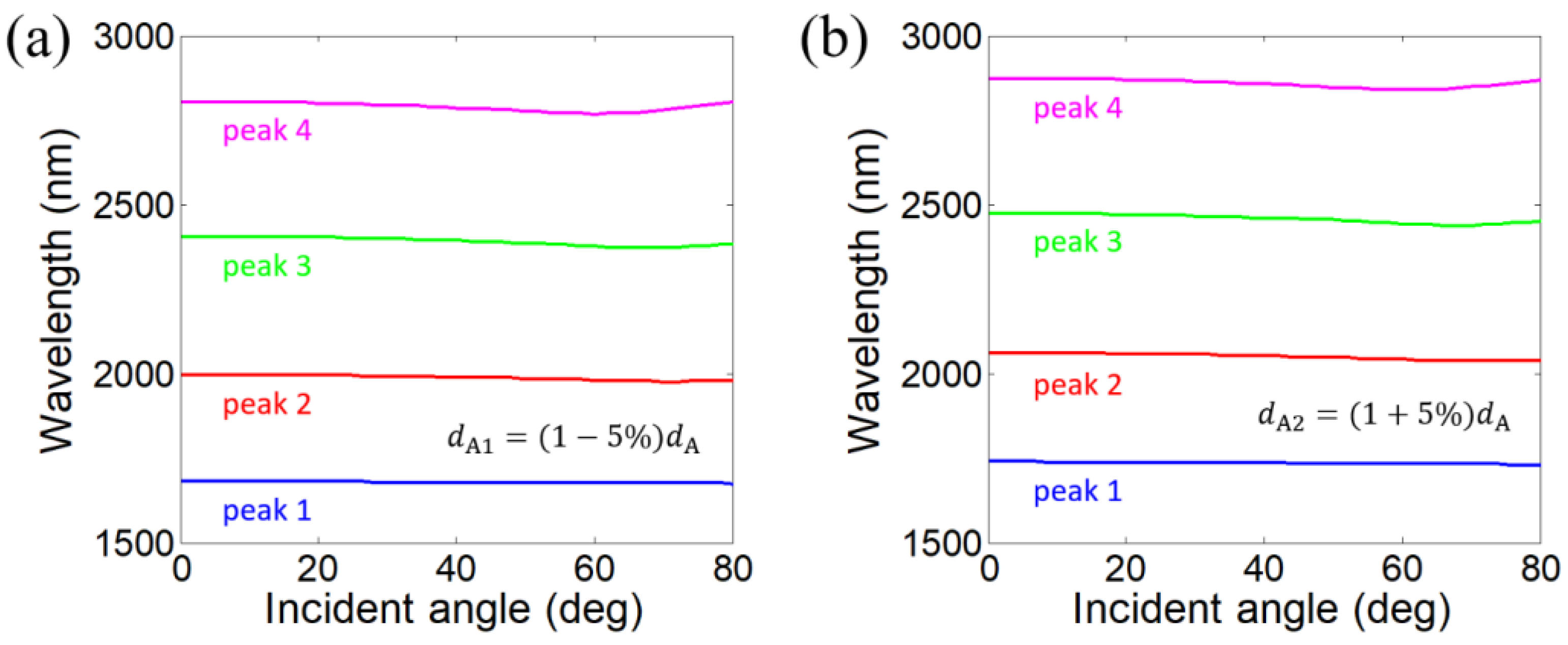
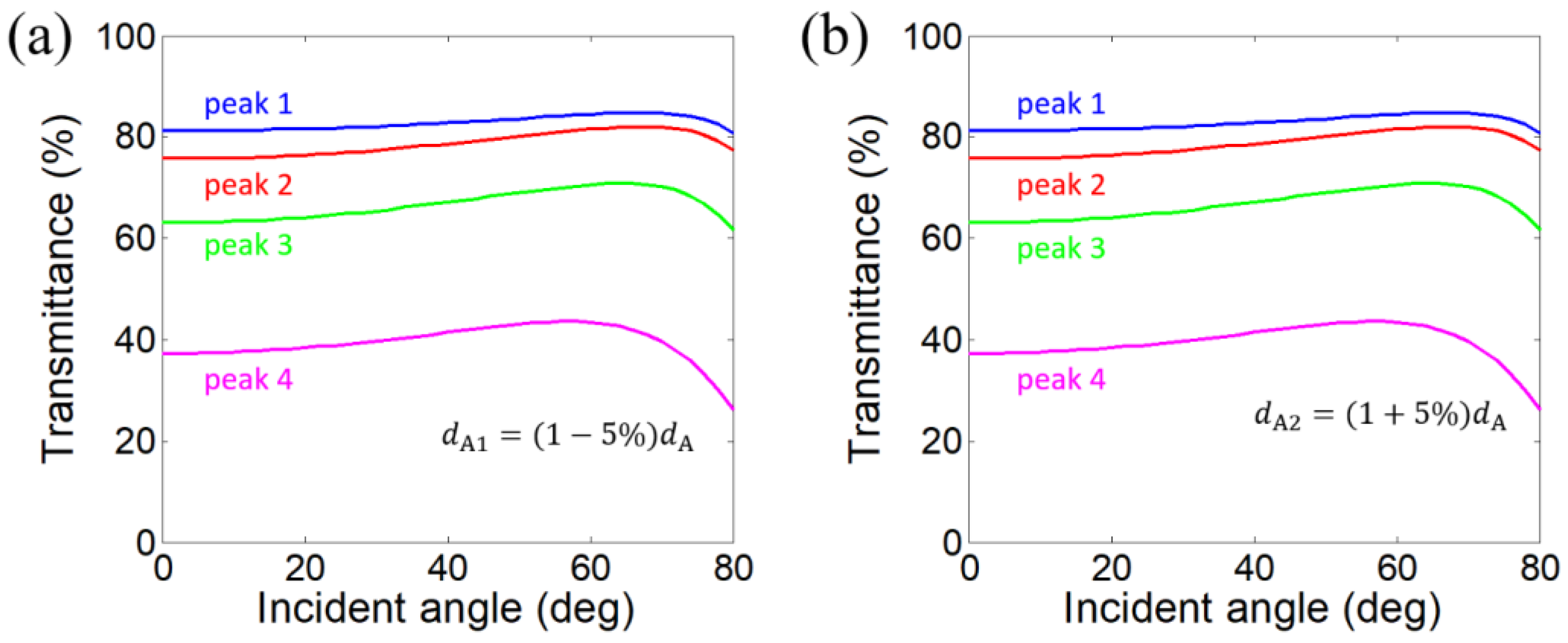
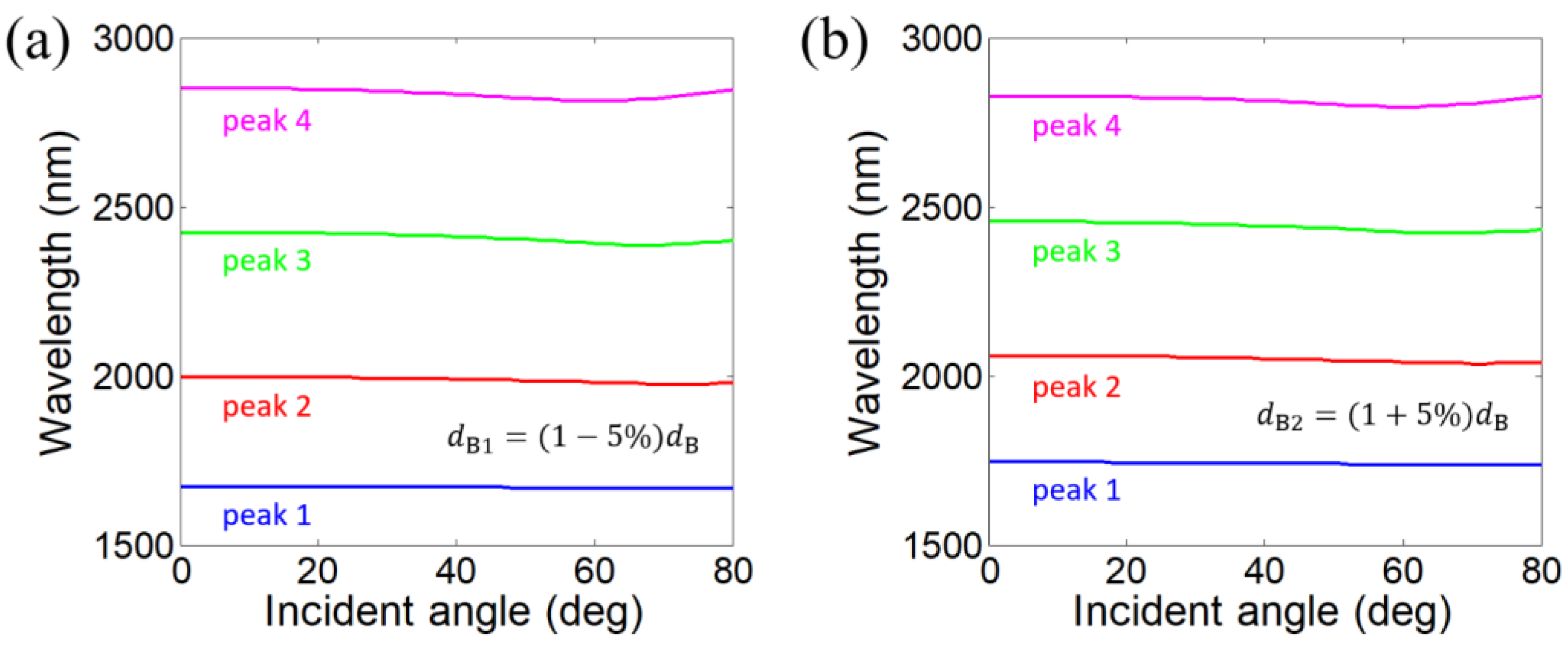
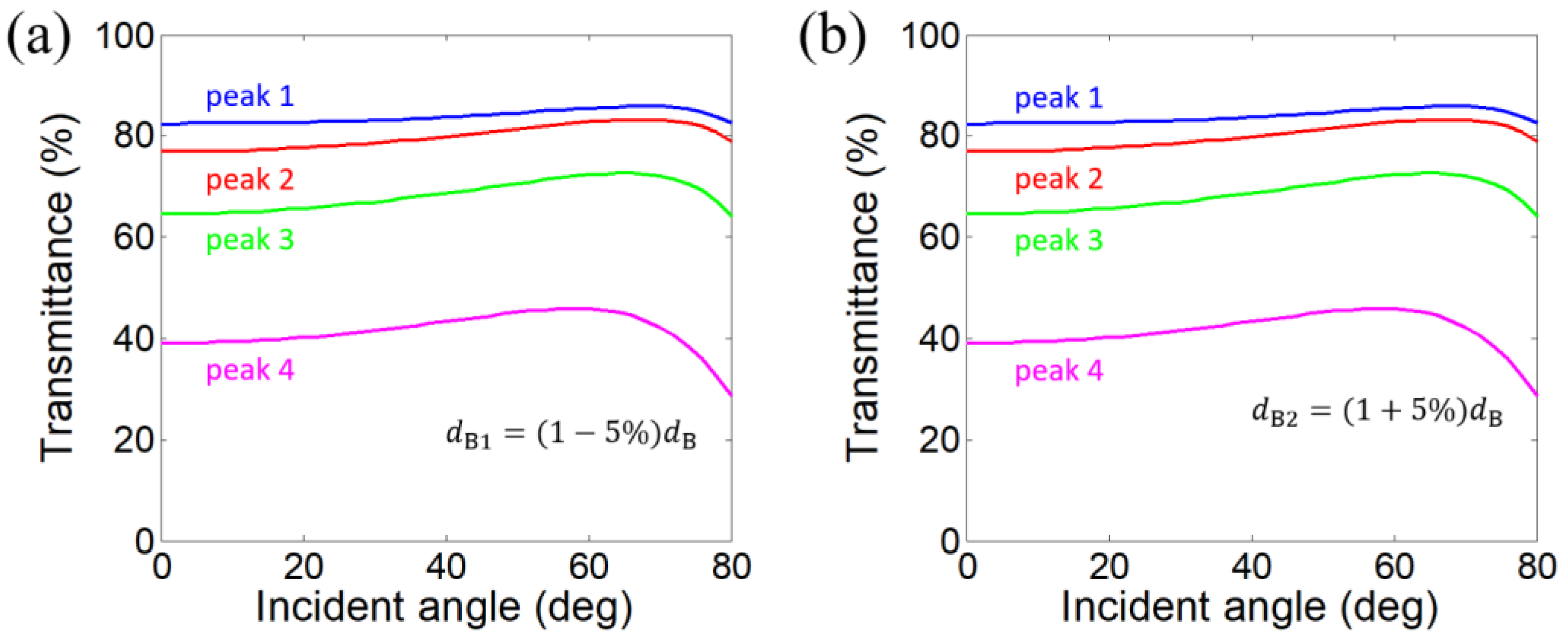
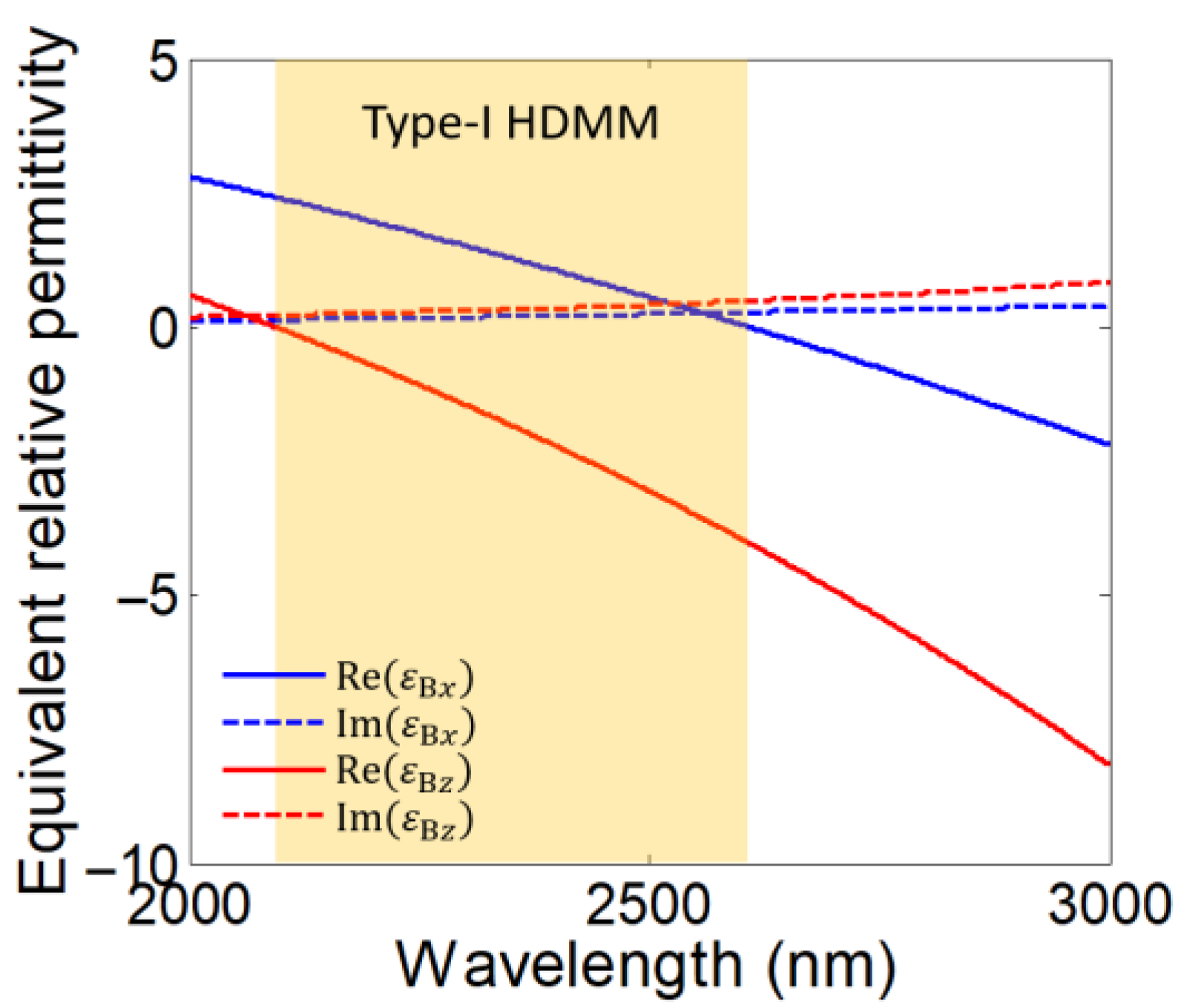

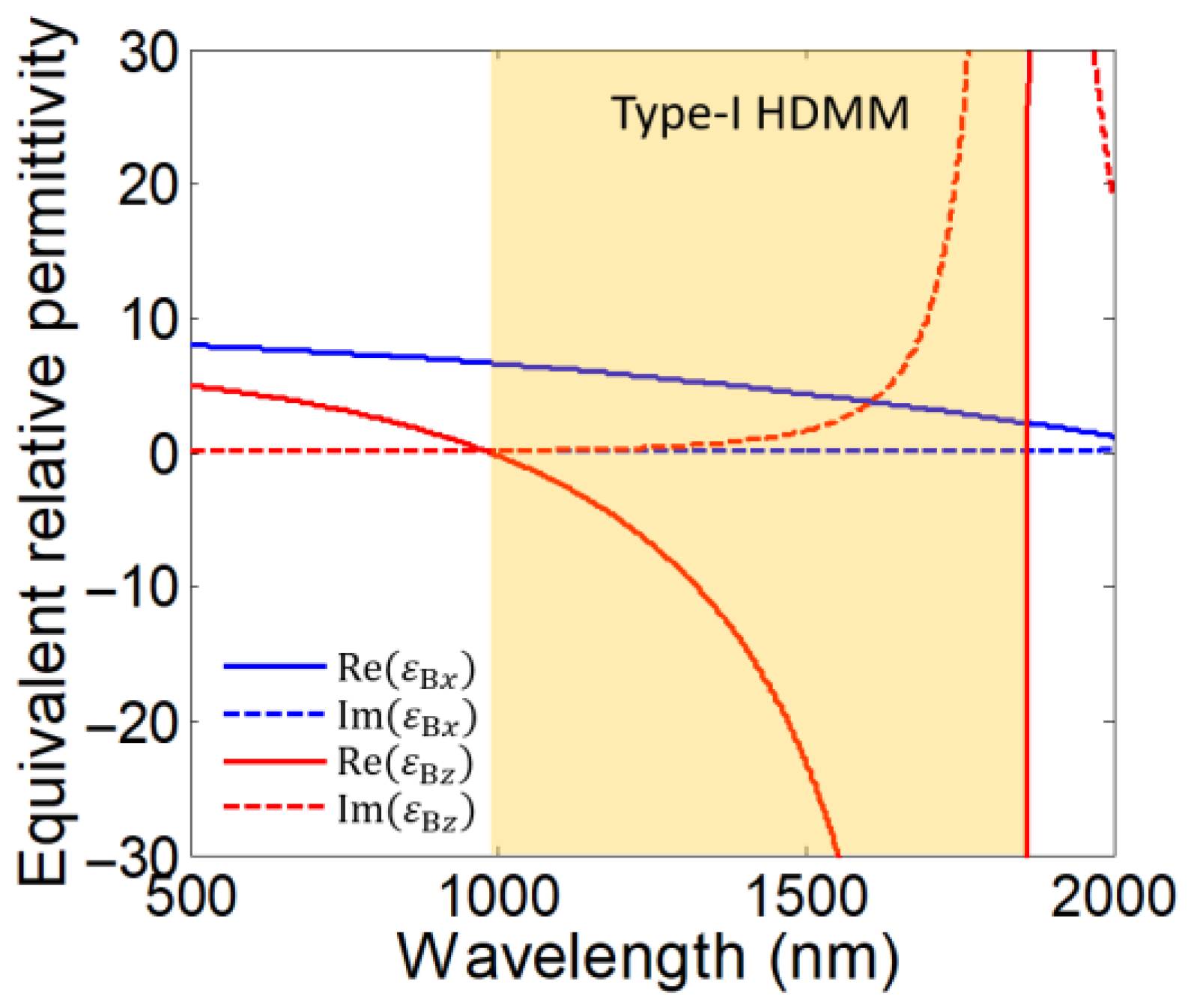

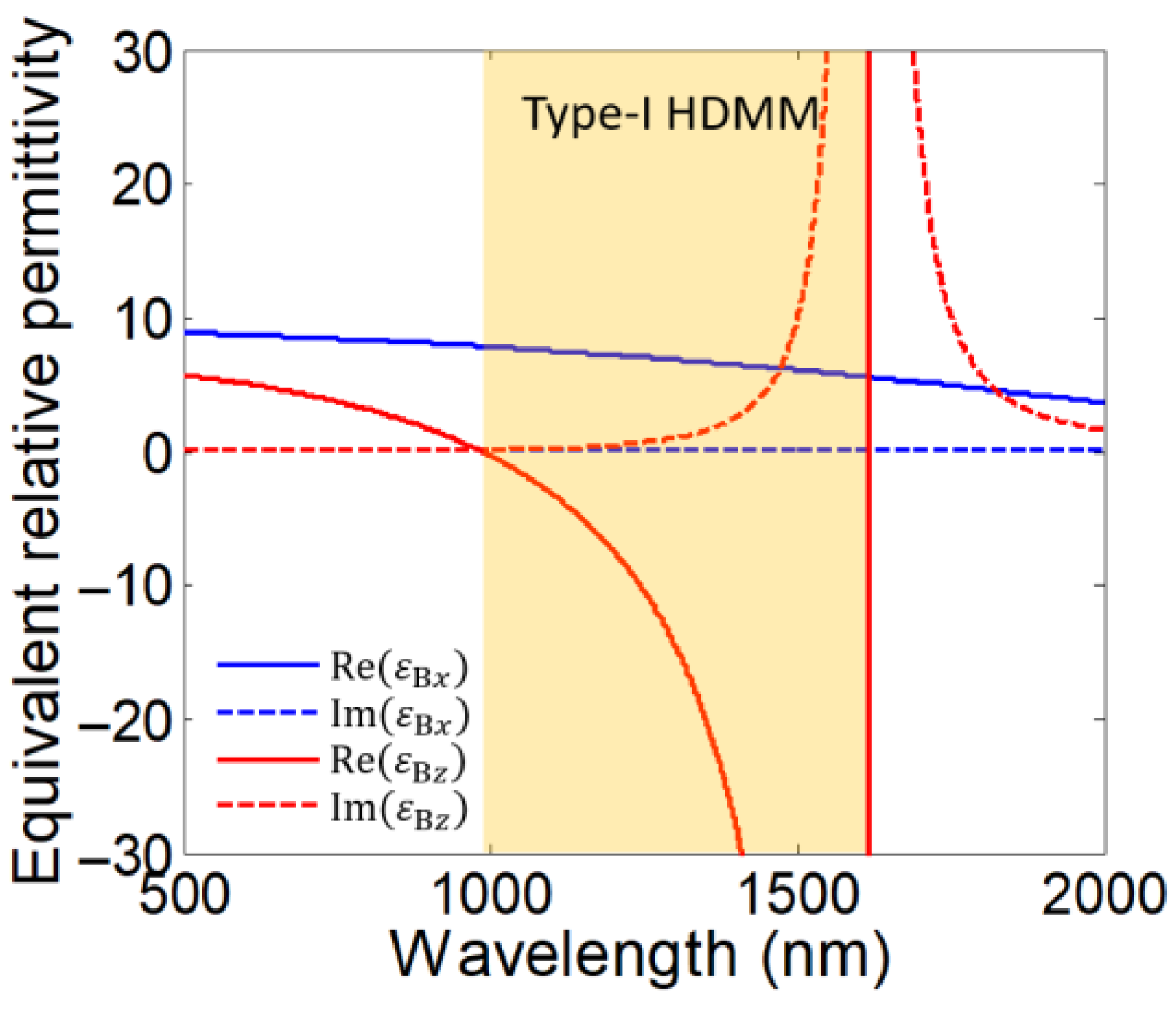
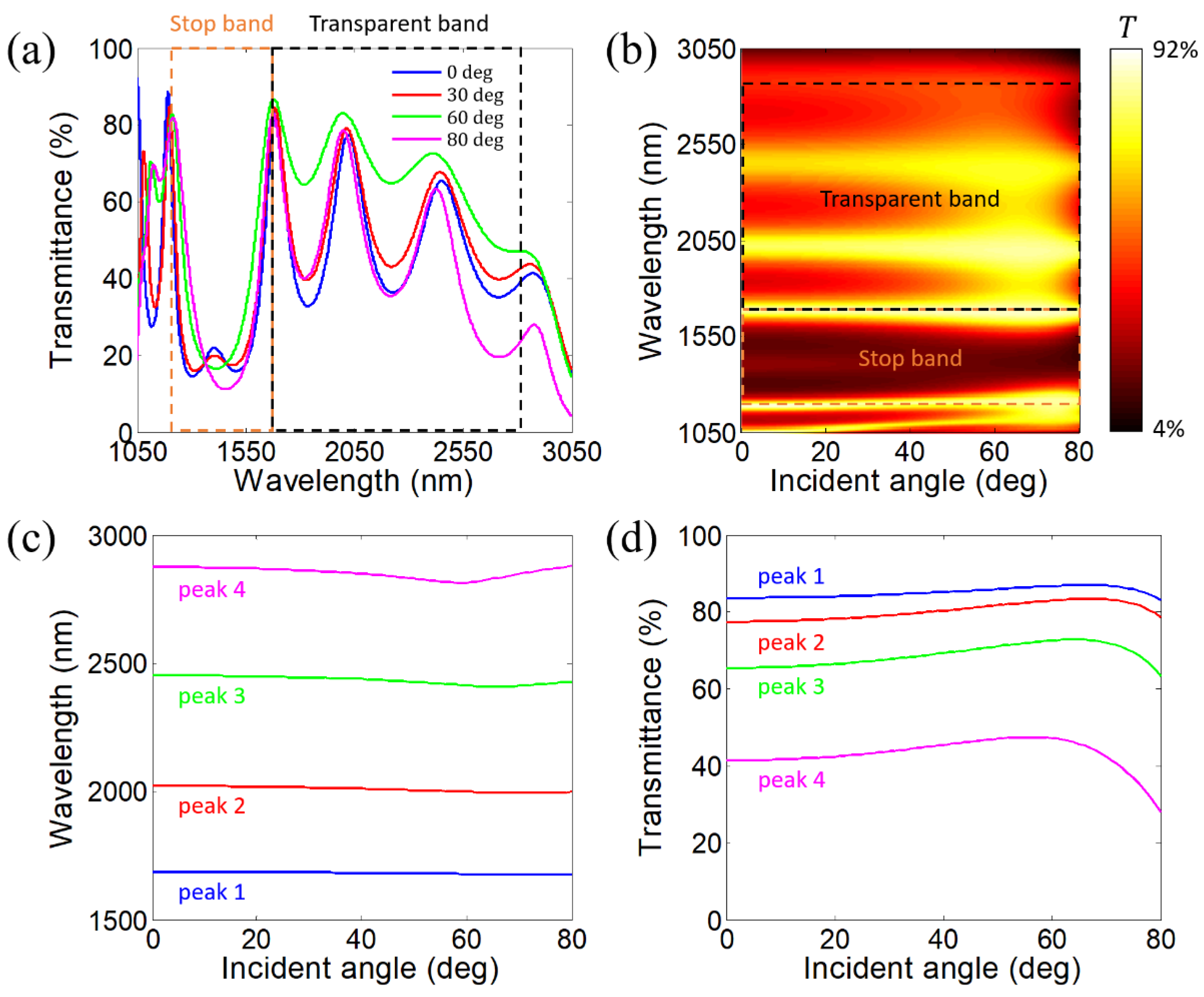
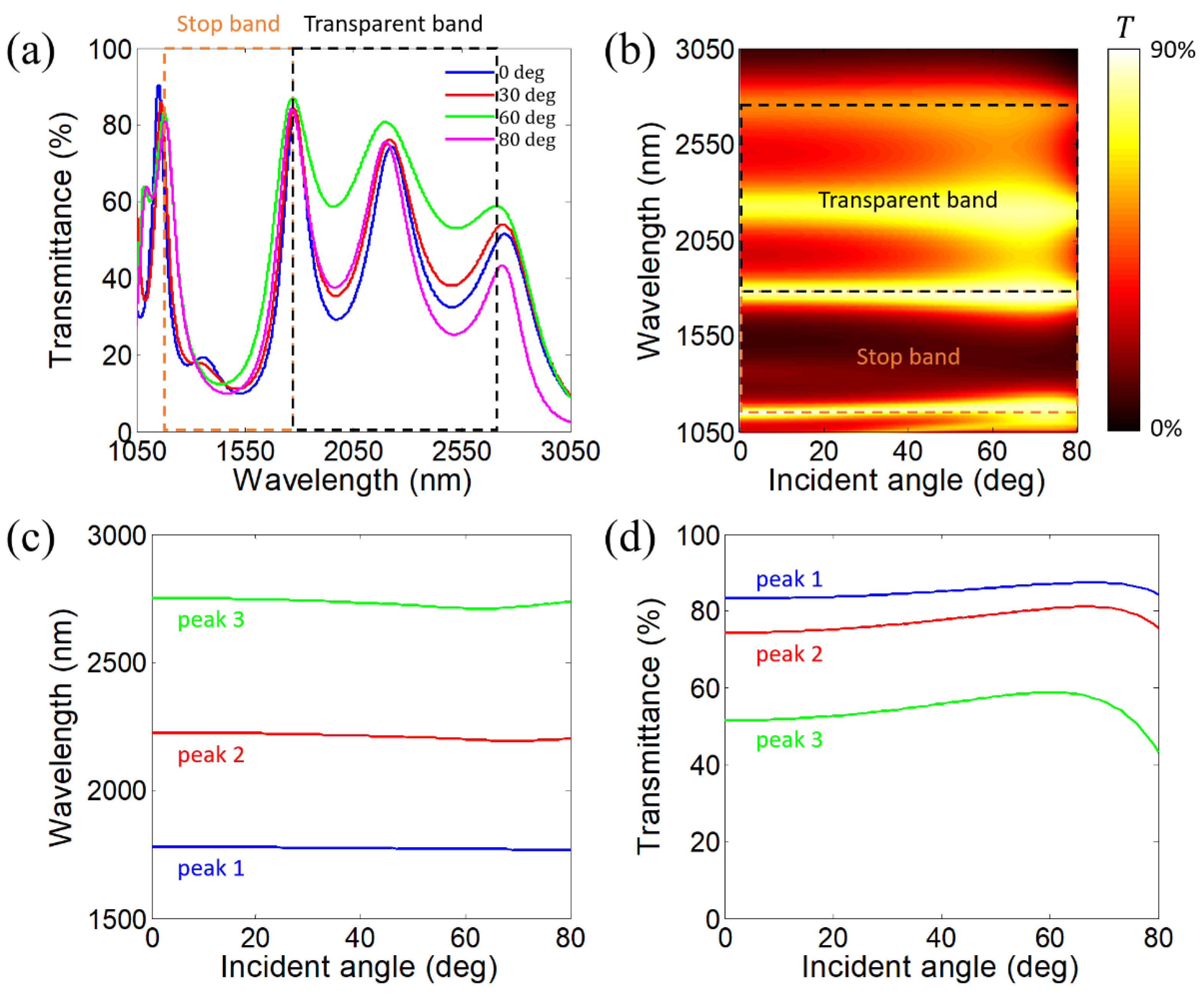
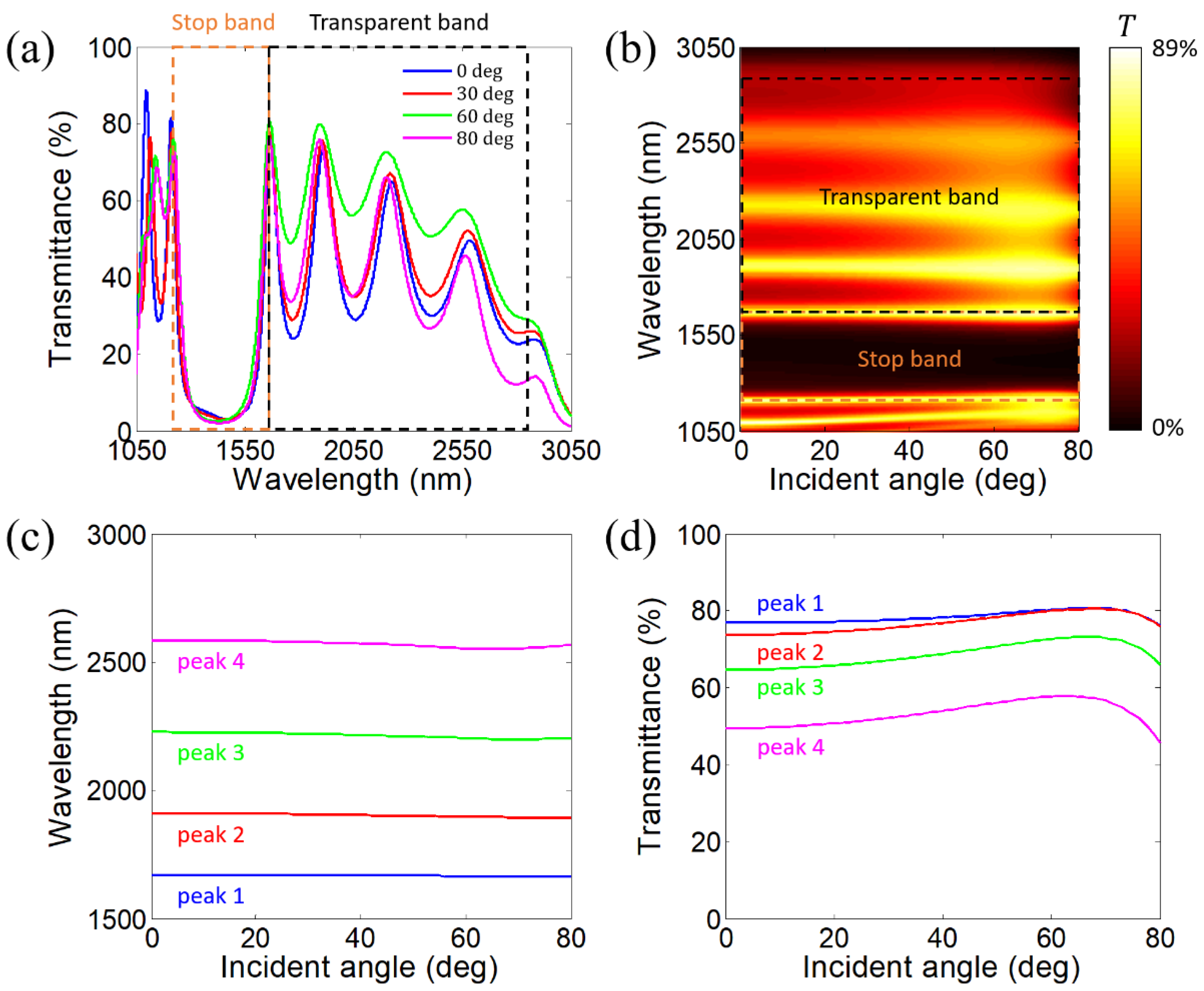
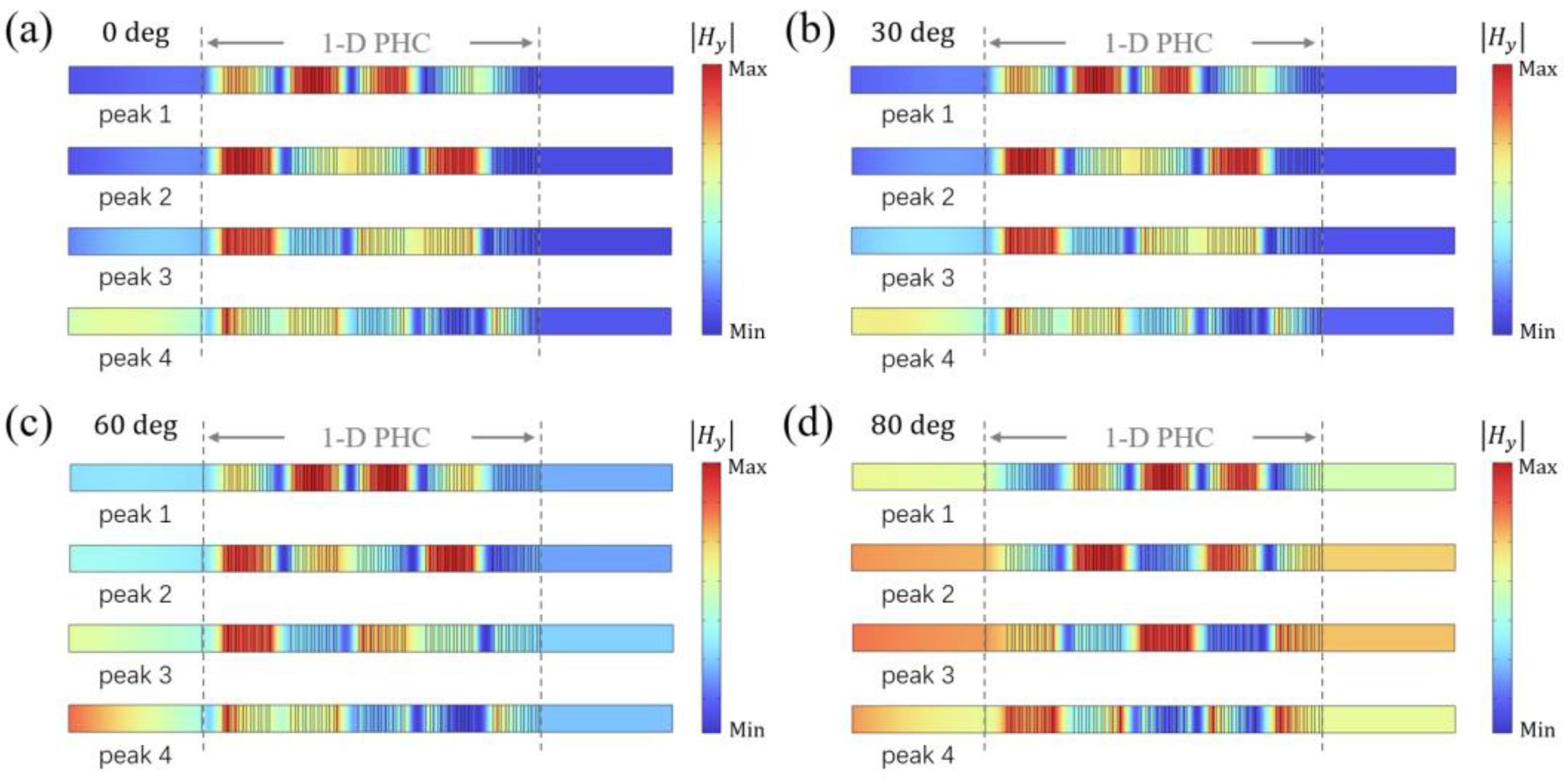


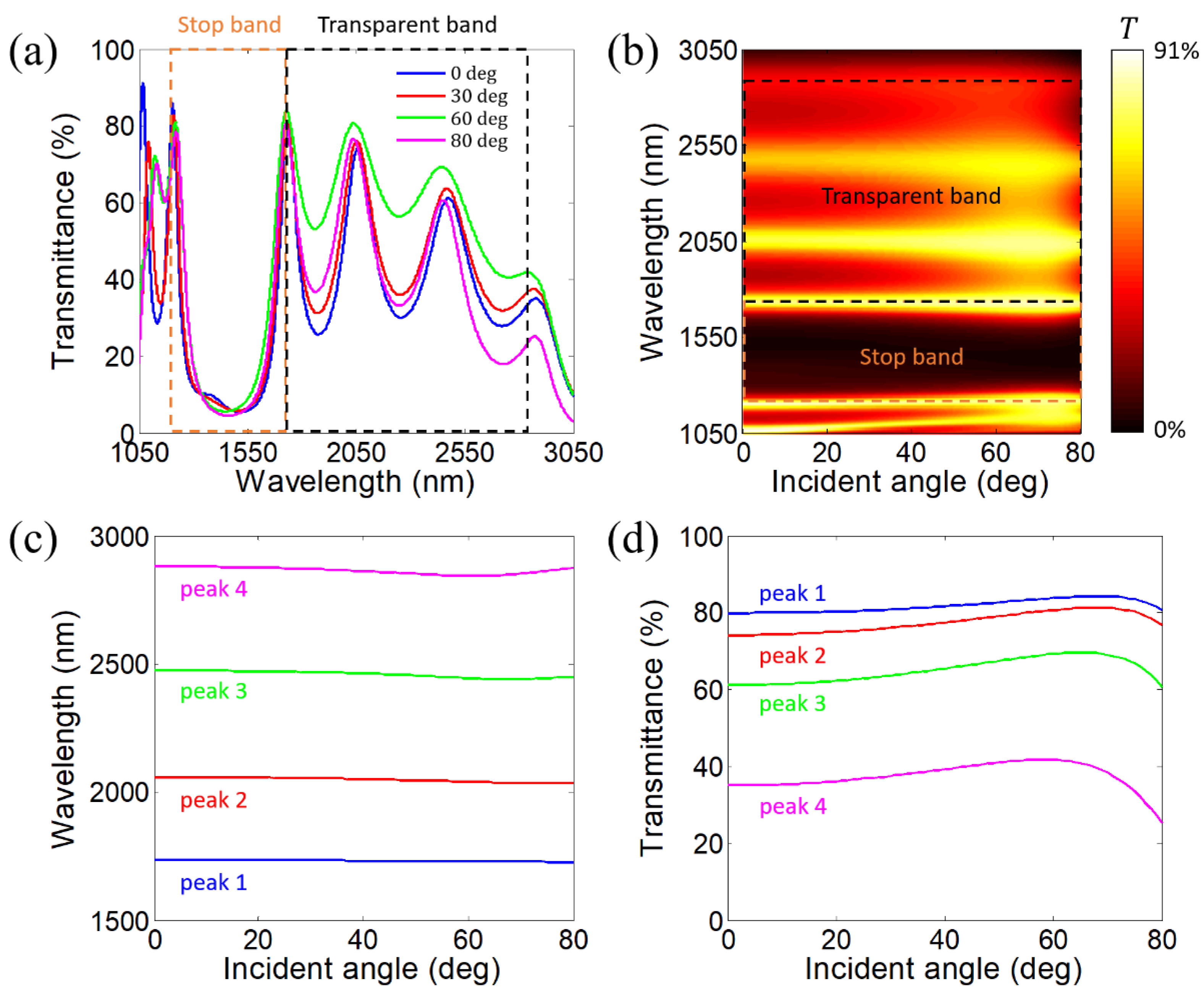
| Work | Structure | Wavelength Range of the Angle-Dispersion-Free Transparent Band | Relative Bandwidth of the Angle-Dispersion-Free Transparent Band |
|---|---|---|---|
| Ref. [58] | Metasurface | 205~281 μm | 31.3% |
| Ref. [59] | Metasurface | 2.79~3.53 cm | 23.4% |
| Ref. [60] | 3-D metamaterial | 3.58~3.79 cm | 5.7% |
| Our work | 1-D PHC | 1.7052~2.8034 μm | 48.7% |
Disclaimer/Publisher’s Note: The statements, opinions and data contained in all publications are solely those of the individual author(s) and contributor(s) and not of MDPI and/or the editor(s). MDPI and/or the editor(s) disclaim responsibility for any injury to people or property resulting from any ideas, methods, instructions or products referred to in the content. |
© 2025 by the authors. Licensee MDPI, Basel, Switzerland. This article is an open access article distributed under the terms and conditions of the Creative Commons Attribution (CC BY) license (https://creativecommons.org/licenses/by/4.0/).
Share and Cite
Wu, F.; Ruan, J.; He, L.; Panda, A.; Jiang, H. Angle-Dispersion-Free Near-Infrared Transparent Bands in One-Dimensional Photonic Hypercrystals. Photonics 2025, 12, 748. https://doi.org/10.3390/photonics12080748
Wu F, Ruan J, He L, Panda A, Jiang H. Angle-Dispersion-Free Near-Infrared Transparent Bands in One-Dimensional Photonic Hypercrystals. Photonics. 2025; 12(8):748. https://doi.org/10.3390/photonics12080748
Chicago/Turabian StyleWu, Feng, Jiayi Ruan, Li He, Abinash Panda, and Haitao Jiang. 2025. "Angle-Dispersion-Free Near-Infrared Transparent Bands in One-Dimensional Photonic Hypercrystals" Photonics 12, no. 8: 748. https://doi.org/10.3390/photonics12080748
APA StyleWu, F., Ruan, J., He, L., Panda, A., & Jiang, H. (2025). Angle-Dispersion-Free Near-Infrared Transparent Bands in One-Dimensional Photonic Hypercrystals. Photonics, 12(8), 748. https://doi.org/10.3390/photonics12080748







